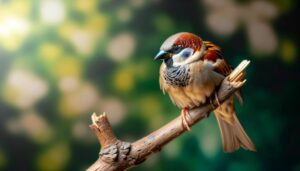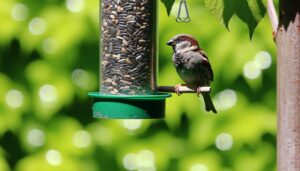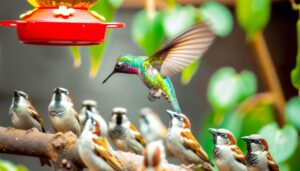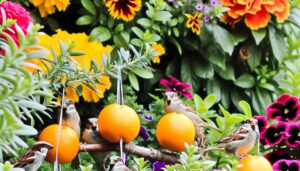How Do House Sparrows React to Safflower Seeds?
House sparrows show limited interest in safflower seeds compared to other seed types. Observations reveal that their feeding activity on safflower is sporadic, likely due to the seed's bitter taste and harder shell.
Although safflower seeds are rich in linoleic acid and vitamin E, sparrows prefer high-energy foods like sunflower seeds, which offer more palatability and nutritional value. Dietary preferences are influenced by taste and local food availability.
Safflower seeds may not be the most effective option for attracting house sparrows, though they can deter less desirable species. Discover further insights into best feeding strategies for sparrows.
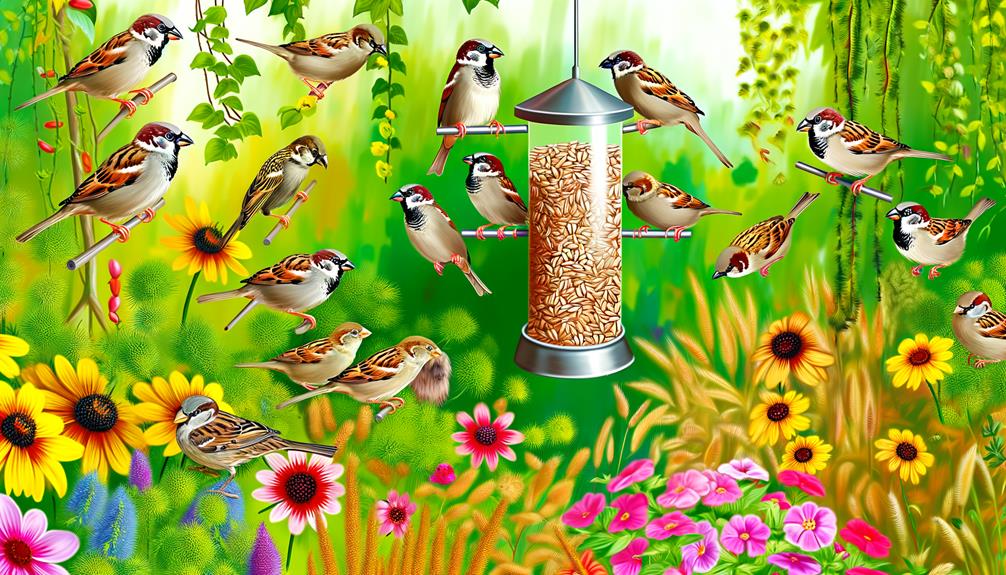
Key Takeaways
- House sparrows exhibit tentative pecking behavior with safflower seeds before seeking other food sources.
- Observations indicate a lower consumption rate of safflower seeds by house sparrows over time.
- Sparrows do not completely reject safflower seeds but prefer other food options.
- The bitter taste of safflower seeds may contribute to sparrows' decreased interest.
- House sparrows show a preference for sunflower seeds over safflower seeds.
House Sparrow Diet Preferences
House sparrows (Passer domesticus) exhibit distinct dietary preferences that are influenced by availability and nutritional content of food sources. These birds are mainly granivorous, feeding mostly on seeds and grains. However, they also display opportunistic feeding behaviors, consuming insects and other small invertebrates, especially during the breeding season to meet increased protein demands.
Their diet is further supplemented by fruits and human-provided foods, such as breadcrumbs. Studies indicate that house sparrows prefer high-energy food sources that optimize their caloric intake, essential for survival and reproductive success. Variations in diet across different geographic locations reflect adaptive strategies to local food availability.
Understanding these dietary preferences is essential for developing targeted conservation strategies and managing sparrow populations in urban and rural environments.
What Is Safflower Seed
Safflower seed, derived from the annual safflower plant (Carthamus tinctorius), has been cultivated for centuries, primarily for its oil and as a component in birdseed. Rich in fats and proteins, it provides significant nutritional benefits for many bird species, including a healthy source of energy.
Understanding bird feeding preferences, including the specific reaction of house sparrows to safflower seed, is essential for effective avian dietary management.
Safflower Seed Origins
Originating from the arid regions of the Middle East, *Carthamus tinctorius*, commonly known as safflower, is a thistle-like annual plant cultivated primarily for its oil-rich seeds. This hardy species thrives in dry climates and has been an essential crop for centuries due to its versatility. Safflower seeds are encased in a hard shell, making them a resilient choice for both agricultural and ornamental purposes. The plant's adaptability to various soil types and its drought resistance contribute to its widespread cultivation. Below is a table summarizing key characteristics of safflower seeds:
| Characteristic | Description | Importance |
|---|---|---|
| Botanical Name | *Carthamus tinctorius* | Scientific ID |
| Origin | Middle East | Historical Roots |
| Seed Composition | Oil-rich | Nutritional Value |
| Growth Conditions | Arid, diverse soils | Agricultural Use |
Nutritional Benefits Overview
Rich in necessary fatty acids and antioxidants, safflower seeds offer a range of nutritional benefits that contribute to overall health. These seeds are particularly high in linoleic acid, a polyunsaturated omega-6 fatty acid essential for maintaining cellular integrity and function.
In addition, safflower seeds contain significant amounts of vitamin E, a potent antioxidant that protects cells from oxidative stress and may enhance immune function. The seeds also provide dietary fiber, which supports digestive health.
Moreover, they are a good source of protein and essential minerals such as magnesium, phosphorus, and iron. These nutritional components make safflower seeds a valuable dietary option, potentially benefiting a variety of organisms, including avian species.
Bird Feeding Preferences
Given their rich nutritional profile, safflower seeds have been increasingly recognized for their potential impact on avian feeding preferences, particularly among species such as house sparrows. Safflower seeds are small, white, and high in protein and fat, making them a robust food source.
Their unique composition includes:
- High Linoleic Acid Content: Essential for energy metabolism.
- Protein-Rich: Supports muscle development and overall health.
- Low Saturated Fat: Promotes cardiovascular health.
- Bitter Taste: Often deters less desirable bird species and pests.
These attributes not only make safflower seeds a nutritionally beneficial option but also influence feeding behaviors. House sparrows, known for their adaptability, may develop a preference for safflower seeds, thereby impacting local avian feeding dynamics and competition.
Nutritional Value of Safflower
Safflower seeds, recognized for their high oil content, provide a significant source of essential fatty acids and protein to house sparrows. The seeds are rich in linoleic acid, a key omega-6 fatty acid, which supports various physiological functions. Additionally, they offer a substantial amount of protein, essential for the growth, repair, and maintenance of avian tissues.
| Nutrient | Amount/100g |
|---|---|
| Protein | 16.2g |
| Fat | 38.5g |
| Linoleic Acid | 29.0g |
This nutrient composition ensures that house sparrows receive the necessary energy and building blocks for optimal health. Furthermore, the high fat content aids in maintaining body temperature and energy reserves, particularly during colder months. Safflower seeds thus serve as a valuable dietary component for house sparrows.
House Sparrows and Safflower
House sparrows exhibit a notable preference for safflower seeds, which can be attributed to their high nutritional value and energy content. These seeds provide essential nutrients and are a dense source of calories, making them an ideal food source.
The consumption of safflower seeds by house sparrows has been documented to influence various aspects of their behavior and physiology.
Key factors include:
- Nutritional Benefits: High protein and fat content support growth and energy.
- Palatability: Sparrows find safflower seeds palatable, which encourages consistent feeding.
- Availability: Safflower seeds are readily available in many habitats frequented by sparrows.
- Digestibility: These seeds are easily digestible, facilitating efficient nutrient absorption.
This preference highlights the significant role safflower seeds play in supporting the dietary needs of house sparrows.
Observational Studies and Findings
Observational studies have revealed key insights into the feeding behavior patterns of house sparrows when presented with safflower seeds.
These studies indicate a marked preference for safflower seeds over other types of bird feed, suggesting specific attractants or nutritional benefits.
Detailed analysis of these patterns could inform broader ecological and behavioral understandings of house sparrow feeding habits.
Feeding Behavior Patterns
In a series of observational studies, researchers meticulously documented the feeding behavior patterns of house sparrows when presented with safflower seeds. The primary objective was to understand how these birds interact with safflower in comparison to other seed types.
Data collection involved recording the frequency, duration, and choice sequences of feeding events. Key findings include:
- Feeding Frequency: House sparrows approached safflower seeds less frequently compared to other seeds.
- Feeding Duration: The time spent consuming safflower seeds was notably shorter.
- Behavioral Responses: Sparrows exhibited hesitation before consuming safflower seeds.
- Interaction Sequences: Initial pecking often led to abandonment of safflower seeds in favor of alternative food sources.
These observations provide a foundational understanding of the feeding dynamics of house sparrows in response to safflower seeds.
Safflower Seed Preferences
Building on the documented feeding behavior patterns, the current subtopic examines house sparrows' specific preferences for safflower seeds through detailed observational studies. Observations revealed that while house sparrows did consume safflower seeds, their preference was notably lower compared to other seed types such as sunflower or millet.
Time-lapse recordings and direct observations indicated sporadic feeding activity on safflower seeds, with sparrows often exhibiting tentative pecking behavior before moving to alternative food sources. Quantitative data supports this, showing a lower consumption rate of safflower seeds over extended periods.
These findings suggest that while house sparrows do not completely reject safflower seeds, they are not their preferred choice, potentially due to taste or nutritional content differences.
Comparing Safflower to Other Seeds
Comparing safflower seeds to other commonly available bird seeds, such as sunflower and millet, reveals distinct differences in nutritional content and bird preferences.
Safflower seeds have a higher fat content but lower protein levels compared to sunflower seeds, which are rich in both fat and protein.
Millet, on the other hand, is lower in fat but provides a good source of carbohydrates.
Nutritional Content:
- Safflower: High in fat, low in protein
- Sunflower: High in fat, high in protein
- Millet: Low in fat, high in carbohydrates
Bird Preferences:
- House Sparrows typically favor sunflower seeds over safflower.
- Safflower is less appealing to certain nuisance species.
- Millet is preferred by smaller birds.
Understanding these differences aids in selecting appropriate seeds for targeted bird feeding.
Benefits of Using Safflower
Given the distinct nutritional profile and bird preferences discussed, safflower seeds offer several advantages for both bird enthusiasts and garden maintenance. Safflower seeds are known for their high-fat content, providing essential energy to birds, particularly during colder months. Their bitter taste deters less desirable species such as squirrels and starlings, ensuring that more preferred birds, like cardinals and chickadees, frequent the feeders. Furthermore, safflower seeds are less prone to spoilage compared to other seeds, promoting cleaner feeding stations.
| Benefit | Description | Target Species |
|---|---|---|
| High-fat content | Provides essential energy | Various songbirds |
| Deterrent properties | Less attractive to unwanted species | Squirrels, Starlings |
| Longevity | Less prone to spoilage | All garden birds |
Potential Drawbacks of Safflower
While safflower seeds are often considered a viable alternative to traditional bird feed, several drawbacks merit consideration. These include the limited nutritional value of safflower seeds compared to other feed options, which may not fully meet the dietary needs of house sparrows.
Additionally, the reduced attraction rate and potential feeding issues, such as difficulty in handling the seeds, can impact the overall effectiveness of safflower as a bird feed.
Limited Nutritional Value
The nutritional profile of safflower seeds is relatively limited, which may not provide the necessary nutrients required for the best health of house sparrows. While safflower seeds are a source of some energy and protein, they lack a complete range of vitamins and minerals essential for avian health. Consequently, their consumption could lead to nutritional deficiencies over time.
Key nutritional limitations of safflower seeds include:
- Low Vitamin A Content: Essential for vision, immune function, and skin health.
- Insufficient Calcium Levels: Critical for bone development and egg production.
- Lack of Essential Amino Acids: Necessitates supplementary protein sources.
- Limited Fatty Acid Profile: Omits key omega-3 fatty acids important for cellular function.
These deficiencies highlight the significance of a varied diet for house sparrows.
Reduced Attraction Rate
Despite their availability, safflower seeds are often less attractive to house sparrows compared to other seed types, which can impact their feeding behavior and population dynamics. This reduced attraction may be attributed to differences in taste, texture, or nutritional content. A comparative analysis demonstrates that house sparrows show a preference for sunflower seeds and millet over safflower, potentially altering their foraging patterns.
| Seed Type | Attraction Level | Impact on Population Dynamics |
|---|---|---|
| Safflower Seeds | Low | Potential decrease in sparrow visits |
| Sunflower Seeds | High | Increased feeding activity |
| Millet | Moderate | Stable feeding patterns |
Understanding these preferences is essential for bird enthusiasts and researchers aiming to manage and support house sparrow populations effectively.
Potential Feeding Issues
In evaluating the potential drawbacks of safflower seeds as a food source for house sparrows, several issues must be considered.
House sparrows, which typically prefer higher-fat seeds like sunflower seeds, may find safflower seeds less appealing. Additionally, safflower seeds possess a different nutritional profile, potentially lacking essential fats and proteins vital for sparrows' health and energy needs. This difference could lead to suboptimal feeding and diminished overall fitness.
Moreover, the harder shell of safflower seeds may require more effort to crack, thereby reducing foraging efficiency.
Tips for Feeding Birds Safflower
When feeding birds safflower, it is crucial to think about the type of feeder and placement to guarantee maximum consumption and minimize waste.
Tube feeders with smaller ports are effective, as they limit access to larger, non-target species while accommodating smaller birds. Placing the feeder in a sheltered location can reduce spillage due to wind and protect the seed from precipitation. Additionally, positioning feeders away from dense foliage minimizes access for predators, enhancing bird safety.
Regular cleaning of feeders is necessary to prevent mold growth and maintain bird health. It is also wise to monitor the feeding area for signs of spoilage or unwanted pests, ensuring the safflower remains a nutritious food source for the intended avian species.
Alternatives to Safflower
While safflower is a popular choice for feeding birds due to its nutritional benefits and ability to deter certain pests, other seeds and food types can also serve as effective alternatives to attract a diverse array of avian species. These alternatives offer various nutritional profiles and can cater to different bird preferences, thereby enhancing biodiversity in feeding areas.
- Black-oil sunflower seeds: Rich in fat and protein, suitable for many seed-eating birds.
- Nyjer (thistle) seeds: Preferred by finches, providing essential amino acids and oils.
- Millet: Commonly favored by ground-feeding birds, offering carbohydrates and proteins.
- Peanut hearts: High-energy option, attracting woodpeckers and other nut-eating species.
Using these alternatives can support a balanced diet and broaden the spectrum of bird species frequenting feeders.
Final Thoughts on Safflower
Safflower's unique ability to attract specific bird species while deterring pests makes it a valuable addition to any bird-feeding regimen. Its high oil content and hard shell are particularly appealing to cardinals and chickadees, yet less so to house sparrows and squirrels. This selective attraction can enhance avian diversity in feeders.
Scientifically, safflower's biochemical properties reduce its palatability to pest species, minimizing competition for food resources. However, it is essential to monitor local bird populations as regional differences may alter effectiveness.
Incorporating safflower into a broader seed mix can optimize feeding strategies, balancing attraction and deterrence. Ultimately, safflower offers a strategic, low-maintenance option for bird enthusiasts aiming to support beneficial species while managing pest populations.
Conclusion
The interaction between house sparrows and safflower seeds can be likened to a carefully balanced ecosystem, where specific dietary preferences and nutritional values influence avian behavior.
Observational studies indicate that while house sparrows may occasionally consume safflower, its efficacy as a food source remains variable. Potential drawbacks such as seed rejection and nutritional limitations must be considered.
As a result, a multifaceted approach, incorporating alternative seeds, proves essential for optimizing avian dietary strategies.

